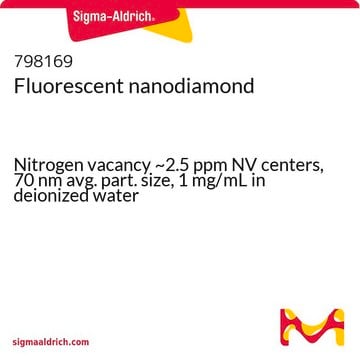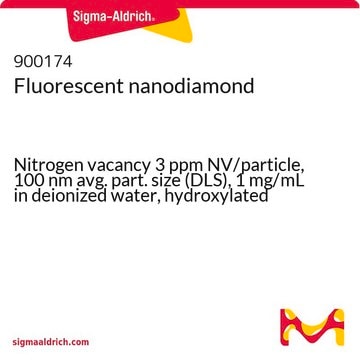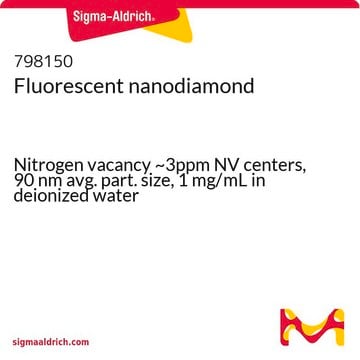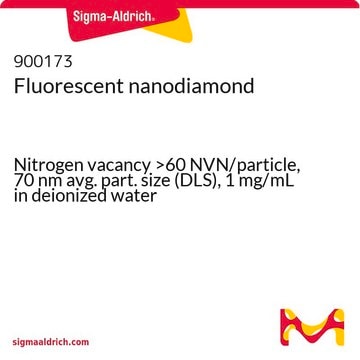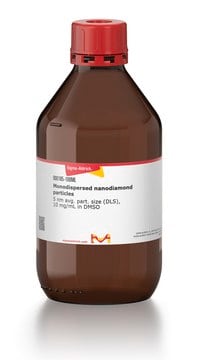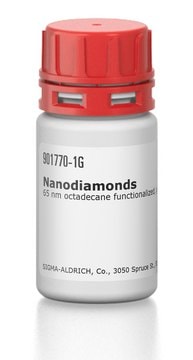Please see the image below to review the spectral data for this product.
798088
Fluorescent nanodiamond
Nitrogen vacancy ~3 ppm NV centers, 120 nm avg. part. size, 1 mg/mL in deionized water
Synonym(e):
Diamond nanopowder, Nanodiamonds
Größe auswählen
About This Item
Empfohlene Produkte
Form
suspension
Qualitätsniveau
Zusammensetzung
Nitrogen vacancy, ~3 ppm NV centers
Konzentration
1 mg/mL in deionized water
Durchschnittliche Teilgröße
120 nm
Suchen Sie nach ähnlichen Produkten? Aufrufen Leitfaden zum Produktvergleich
Verwandte Kategorien
Allgemeine Beschreibung
Lagerklassenschlüssel
10 - Combustible liquids
WGK
nwg
Flammpunkt (°F)
Not applicable
Flammpunkt (°C)
Not applicable
Hier finden Sie alle aktuellen Versionen:
Besitzen Sie dieses Produkt bereits?
In der Dokumentenbibliothek finden Sie die Dokumentation zu den Produkten, die Sie kürzlich erworben haben.
Kunden haben sich ebenfalls angesehen
Artikel
Fluorescent Nanodiamond Particles (FNDs)- Find properties and applications of nanodiamond particles.
Fluorescent Nanodiamonds and biofunctionalization strategies are detailed for imaging and bioconjugation applications.
Biomaterials science integrates smart materials into biological research, requiring a deep understanding of biological systems.
-
I would like to see the fluorescence response of 798088
1 answer -
1. Is your inflorescence nanodiamond dyed?
2. What are the excitation and emission wavelengths for them? are their quantum yield and brightness information available?
3. What is the function of the PEG functionalization here? Does it reduce surface tension? Does the functional group affect the fluorescent intensity?
4. Has it been used for some fluorescent tracing experiments?1 answer-
1 The fluorescence originates from the nanodiamonds centers, such as nitrogen-vacancy (NV), NVN, or N3, and not from any fluorescent groups. Therefore, it is not dyed.
2 The excitation/emission wavelengths are consistent for these products and are based on the nanodiamonds center. The catalog part numbers, center type, excitation peak, emission peak, and brightness information are as follows:
900173, NVN, 480 nm, 520 nm (green), ~90x vs FITC
All other products, NV, 570 nm, 680 nm (red), ~70x brighter vs Atto 647 Two important notes provided were:
Green fluorescence is brighter than red.
Longer wavelengths, such as red light, have better penetrability.
3 PEG functionalization historically reduces non-specific binding and aggregation in buffered media. Carboxylated particles are commonly used for sensing and imaging applications, or to conduct further syntheses in the lab. However, in biological media/buffer (e.g., PBS), they are prone to aggregation, and surface coatings help to reduce this. Moreover, other functionalizations, such as biotin or antibodies, allow for selective targeting.
4 Threr is information available that it has been used in fluorescent imaging experiments.Helpful?
-
Active Filters
Unser Team von Wissenschaftlern verfügt über Erfahrung in allen Forschungsbereichen einschließlich Life Science, Materialwissenschaften, chemischer Synthese, Chromatographie, Analytik und vielen mehr..
Setzen Sie sich mit dem technischen Dienst in Verbindung.
